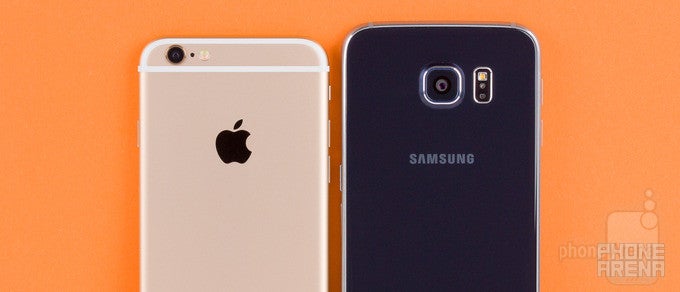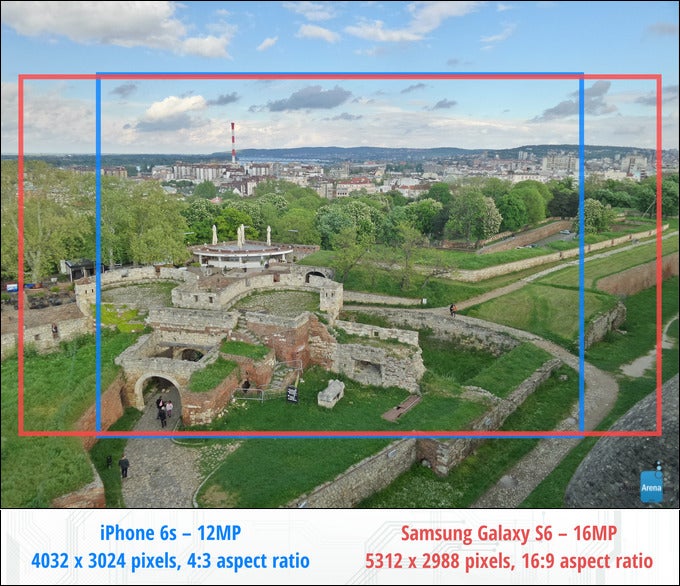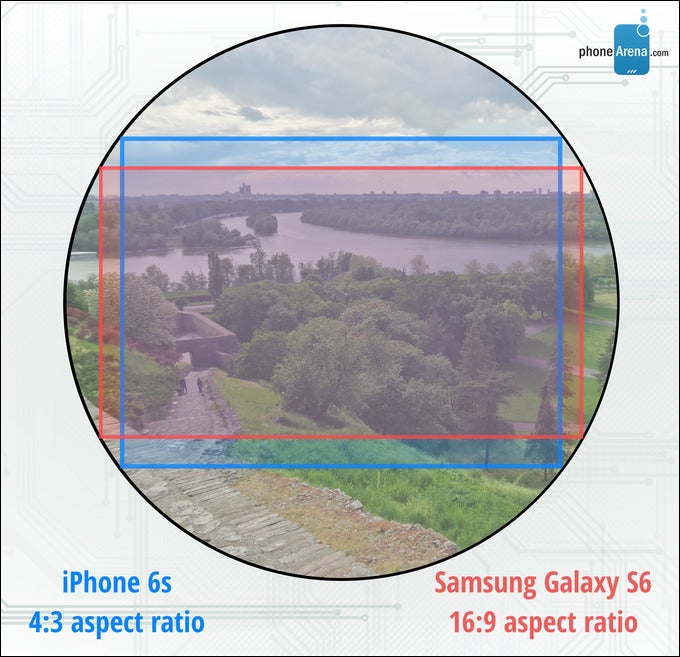Camera comparison: the 12MP iPhone 6s vs the 16MP Galaxy S6, or why megapixels aren't all that matters in a camera

Getting the full picture
A variable that rarely gets mentioned in a smartphone's camera specs is the sensor's native aspect ratio. That's the proportional relationship between the width and the height of the pixel array of the image sensor – the iPhone's camera shoots 12MP photos at 4032 by 3024 pixels for an aspect ratio of 4:3, while the Galaxy S6 takes 16MP images at 5312 by 2988 pixels, which equates to an aspect ratio of 16:9. Here's how these figures and proportions look when visualized:

But the rabbit hole goes even deeper
The visualization above isn't perfect, as we haven't taken the two cameras' focal lengths into account. Focal length, expressed in millimeters (mm), goes hand in hand with the horizontal and vertical viewing angles of the camera – a smaller focal length translates to a wider viewing angle and vice versa. But to keep things simple, we've chosen to ignore this variable as it makes a very small difference in our case. The iPhone 6s and Galaxy S6's cameras have focal lengths of 29mm and 28mm respectively.
Another factor that we've skipped is that the two sensors pick up different areas of all the light entering the sensor. To get a better understanding of what we mean, take a look at the graphic below. The black circle represents the area illuminated by the light entering the camera. Note that the area has a circular shape because the camera's lenses are, you know, circular. But the image sensor is a rectangle. It produces rectangular images that we view on rectangular screens. This brings us back to aspect ratio and how it affects images. In our particular case, the Galaxy S6 produces wider images, while the iPhone 6s has a wider vertical field of view, all because of the difference in aspect ratios between the two sensors.

A look at real-life photo samples
Now seems like a fine time to leave theory aside and have a look at some real-life photo samples. In the slideshow below you'll see three pairs of images taken with the iPhone 6s and the Galaxy S6 under identical conditions. In addition to the full-resolution images, we've also included crops at 100% zoom to demonstrate that there's barely any difference in the amount of detail captured by the two cameras. And when there is, it is caused by the two cameras' sharpening and image processing algorithms, not by the difference in megapixel count. At the same time, the full-resolution images demonstrate the difference in the two cameras' horizontal and vertical angles of view caused by their differing aspect ratios – the phenomenon we highlighted above. Feel free to zoom in on those to explore and compare the quality of details captured by the two cameras.
Please note that the slideshow contains full-resolution images that might take a while to load.
Conclusion
Megapixels are not all that matters in a camera – that's the one thing we hope you'll walk away with after reading this article. Clearly, in the case with the iPhone 6s and the Galaxy S6, the latter's 33% higher megapixel count does not result in a dramatic difference in detail quality. There's barely any difference at all, as the above photos confirm, and when there is, it is because other factors come into play, not because one camera has more megapixels than the other. This serves as a reminder that cameras are complex systems. Assessing two cameras' qualities by comparing a single specification could be misleading and plain wrong, regardless of what a sales representative or a company's marketing department wants you to believe. At the end of the day, the best method to tell if one camera is really better than another remains a comparison between the images produced by the two. And trusting what your eyes like better, of course, instead of weighing figures side by side.
Follow us on Google News













Things that are NOT allowed:
To help keep our community safe and free from spam, we apply temporary limits to newly created accounts: